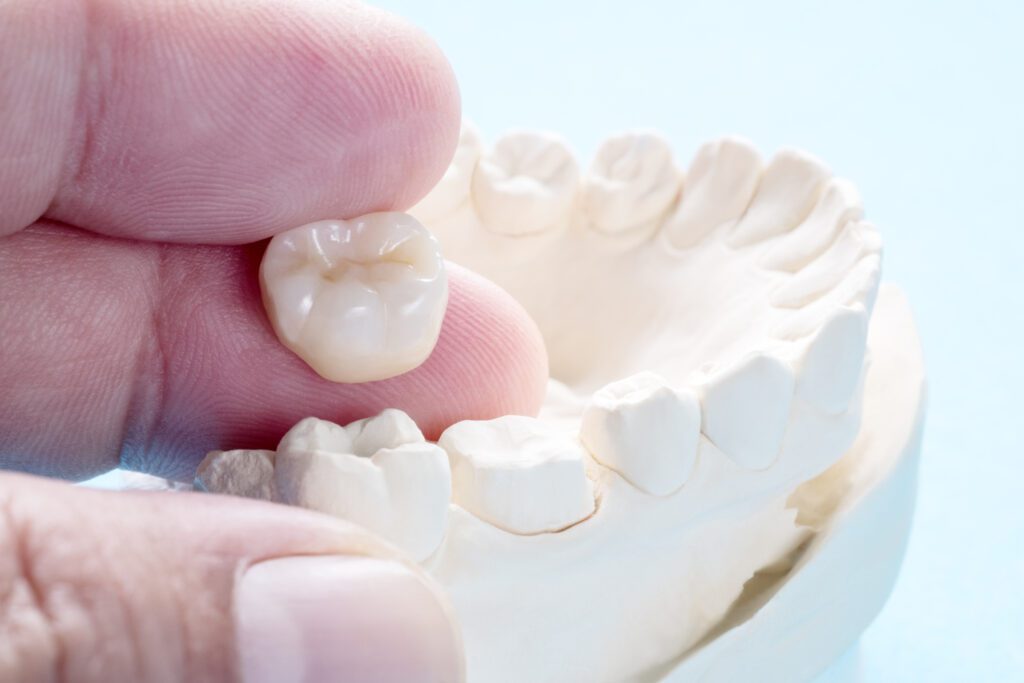Most dental work looks like dental work, but our goal is to make your dental restorations look and feel like natural teeth. We can replace old crowns and fillings with ones that blend in with your smile. Even if your teeth seem too damaged to fix, we can use porcelain or porcelain fused to gold crowns to make them look as good as new. If you need a dental crown in Plano, TX, our office can help. Crowns are a reliable way to repair severely damaged teeth in our Plano, TX dental office.
A dental crown is a cap that fully covers a damaged tooth. It looks and feels like a natural tooth and can also strengthen your tooth. In addition to crowns, we offer other restorative dental treatments for our patients in Plano.

Dental Crown Treatment in Plano, TX
We take pride in the quality of our dental work and the improvements we make for our patients. Crowns can solve major dental problems and usually, last 20 to 30 years, making them a long-term solution for many issues.
Before placing a crown, we use digital technology, like X-rays, to find any dental problems. This helps us decide if a tooth crown is the right choice for your dental needs.
How Long Does It Take To Get a Crown?
Getting a crown usually takes two visits. On the first visit, we remove any decay, shape the tooth, and place a temporary crown made of plastic or metal. We will make sure you’re comfortable by numbing your tooth before treatment.
At the second visit, we remove the temporary crown and fit your new, permanent one. After any needed adjustments, we cement the crown in place, giving you a new, natural-looking tooth.
Some of the benefits of dental crowns include:
- Replace missing teeth
- Support misshapen or broken teeth
- Look completely natural
- Fix chewing and smile problems
What Can Dental Crowns Treat?
Crowns and bridgework are great for fixing serious dental problems caused by accidents, decay, or wear and tear. We use high-grade porcelain or porcelain fused to gold for these repairs, which are long-lasting and look natural.
Crowns and dental bridges are good options for:
- Teeth damaged by accidents
- Teeth worn down by use
- Broken or large fillings
- Missing teeth
- Teeth with root canals that need extra support
Many people have pain in their back teeth because of cracks in the chewing surface. Placing crowns on these teeth can relieve pain and restore full function. Crowns also prevent further damage to weakened teeth.
Old fillings in the front teeth can stain or chip, affecting how your teeth look. In cases where veneers aren’t enough, crowns or bridges may be a better choice. Crowns also help protect teeth with large fillings that are at risk of breaking. We can also use them to complete the restoration of a dental implant; this ensures a perfect match with your real teeth.
Patient Review
Types of Dental Crowns
Dentists offer different types of crowns to choose from, such as:
- Gold: Gold or metal crowns are durable but more noticeable. These are best for back teeth where they won’t be seen as much.
- Zirconia: Made from zirconium dioxide, these crowns are strong but cost more than other options.
- Ceramic: Common for same-day crowns, ceramic is a good option if you’re in a hurry, though it may not last as long as other materials.
- Porcelain: Porcelain crowns are popular because they match the natural color of your teeth. They’re strong and don’t cost as much as zirconia crowns.
- Porcelain Fused to Metal (PFM): These crowns combine the strength of metal with a layer of porcelain for a natural look and extra durability.
The cost of your crown will depend on the type of crown you choose, the number of crowns you need, and the condition of your teeth. Many dental insurance plans cover part of the cost of crown treatment, so be sure to check with your provider.
If you need a dental crown or have questions, contact our Plano, TX office to schedule a consultation. We’re here to help restore your smile with high-quality care.
Inlays and Onlays
When a tooth has damage on more than half of its biting surface, our dentist may recommend an inlay or onlay. These are also called partial crowns. An inlay is used for damage within the cusps of the tooth, similar to a filling. An onlay is like an inlay but covers one or more of the tooth’s cusps.
Inlays and onlays can consist of porcelain, gold, or composite resin. We bond these pieces to the damaged part of the tooth. Gold used to be the most common material for inlays and onlays, but porcelain is now more popular because it’s strong and can match the color of your teeth.
Regular fillings can weaken a tooth by up to 50%, but inlays and onlays can strengthen it by up to 75%. The dentist bonds these restorations to the tooth with strong resins and can last 10 to 30 years. If a tooth is not damaged enough for a full crown, an onlay can be a good option.
How Are Inlays and Onlays Applied?
Getting an inlay or onlay usually takes one or two visits. During the first visit, the dentist removes the damaged or decayed part of the tooth and prepares it for the inlay or onlay.
We take an impression of the tooth to make sure it fits well, and then send it to a lab to create the inlay or onlay. While waiting for the permanent piece, the dentist will place a temporary sealant on the tooth.
At your next appointment, we’ll remove the temporary sealant, check the fit of the inlay or onlay, and bond it to the tooth using a strong resin. We’ll then polish it for a smooth finish.
How to Care for Dental Crowns

Dental patient before and after a dental crown treatment.
Dental crowns typically require two or three visits. At the first appointment, we prepare the tooth and take impressions. While waiting for the custom crown, we place a temporary crown to protect the tooth.
After each visit, it’s normal to feel some sensitivity to temperature and pressure. This should go away after a few weeks. You can take pain medication as directed by our office if needed.
Caring for Temporary Crowns
If your temporary crown comes loose or falls off, call our office and bring it in so we can re-cement it. Keeping the temporary crown in place is important to prevent other teeth from shifting, which could affect the final crown’s fit.
To keep your temporary crown secure, avoid sticky or hard foods, and chew on the opposite side. Brush as usual, but floss carefully to avoid dislodging the temporary crown.
Once your permanent crown is in place, you can brush and floss as normal. Regular dental visits will make sure your crown stays in good condition.
Get a Dental Crown Today
Do you need to fix a damaged tooth? Contact Texas Dental in Plano, TX at 972-381-1888 or schedule an appointment online to get an affordable dental crown.
